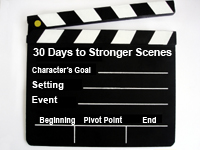The Stuff Between Scenes
Guest Post by Deborah Halverson

 Join us on Facebook for a discussion of scenes.
Join us on Facebook for a discussion of scenes.
As you give thought to what happens in your scenes, give thought, too, to what happens between them. There’s a trove of information and emotion lurking in the white space separating the last line of one scene and the first line of the next. You’re the master manipulator of your story—you should know exactly what’s happening in that space.
Magical Leap. Only in fiction can a kid transport magically from, say, a humiliating moment after school to the next morning when he must deal with the fall-out in the school halls. In real life, we don’t get to skip from scene to scene. We must live those in-between moments, going home and dealing with dinner and the family, doing the dishes and brushing our teeth, trying to sleep only to fail or perhaps achieving sleep only to nightmare—or maybe even sleeping soundly and feeling refreshed in the a.m., determined to take down the bully who served up that monster wedgie during the seventh grade talent show. As a writer, you wouldn’t show all that at-home minutiae to your readers because it would hobble your pacing and nuke the tight tension you’ve built up. But you should know what’s happened in that white space so that you can fully understand how one scene’s ending has simmered and stewed its way into the first line of the next scene.
Simmer. Consider that kid who suffered humiliation—he might interact badly with his family that night if he interacted at all, he’d scrub the dishes and forget to rinse, he’d fumble his dad’s favorite mug and get chewed out, he’d cut his gums with the floss and cry. He’d work himself into a real funk, or a real stink, or a downright rage as his day flowed from terrible to just too much to bear. When something rotten goes down in your life, your minutiae seems to gang up on you, doesn’t it? Don’t start a new scene with the assumption that a character’s emotion and state of mind are exactly where they were when you left him a day or even an hour ago. That’s not realistic and it undermines your scenes. Simmering happens. And that simmering takes place in the white space. By the time your character reaches the opening line of your next scene, he’s in an advanced state of emotion or has had time to hatch a plan, as flawed as it probably will be. Fully understanding how his mindset and emotion have festered during the scene jump allows you to fully exploit both of those things in the happenings of the new scene.
Mull. Mulling is an important part of writing, and that’s what this is—mulling the off-stage events that are part of your character even if you don’t share them with your reader directly. And you won’t. Just as you may know a character’s life story but won’t deliver it when you introduce him, you don’t deliver the stuff in between scenes even though you know it. Go there in your mind.
Props and Dialogue. In a practical sense, you’ll use writing techniques like prop manipulation and dialogue interruptions to show the character’s simmered psyche to readers. For example, if exasperation has built up in the white space, your character will be acting on that exasperation as he moves into the new scene, stubbing his pencil point or kicking his brother’s shoes out of the way or blowing off friends mid-sentence or cussing out his combination lock as the scene commences. A humiliated girl might have spent the white space in her closet, digging out the baggiest, most nondescript outfit she could find, only to unknowingly pick something infected with that weird orange mold that afflicts long-buried clothes in houses near the beach, the kind of mold that smells vaguely of vomit. These are the details you’ll know as you go into the next scene, where your character is already dressed and has to go face-to-face with something or someone in that advanced state of mind. And with that funky aroma.
What happens in the jump between scenes, the stuff that readers don’t see, is important to your character. If you know what happens, your readers will feel it.
 Deborah Halverson is the award-winning author of the teen novels Honk If You Hate Me and Big Mouth (Delacorte/Random House) and the forthcoming Writing Young Adult Fiction for Dummies (June 2010) A former editor for Harcourt Children’s Books, Deborah also runs the writers’ advice website Dear-Editor.com. www.DeborahHalverson.com, www.Dear-Editor.com.
Deborah Halverson is the award-winning author of the teen novels Honk If You Hate Me and Big Mouth (Delacorte/Random House) and the forthcoming Writing Young Adult Fiction for Dummies (June 2010) A former editor for Harcourt Children’s Books, Deborah also runs the writers’ advice website Dear-Editor.com. www.DeborahHalverson.com, www.Dear-Editor.com.
Since I just finished NaNoWriMo, this was the perfect time to read this blog. It’s going to be so helpful in the finishing and revision processes. I’ve read lots of “how to” books but this seemed the easiest one to understand and implement. Thanks, Deborah. (Can’t wait for “YA Fiction for Dummies” to reach the shelves!)
Best Wishes,
Patti Mallett
Very interesting. I hadn’t thought about dwelling on those in-between scenes – I knew what happened, but not in emotional detail. Thanks for the tip! :)